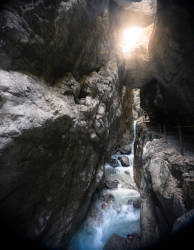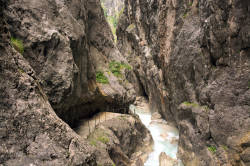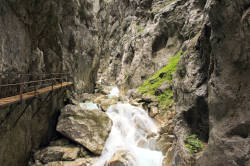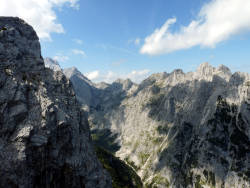Höllentalklamm
Useful Information


| Location: |
Höllentalstraße 18, 82491 Grainau.
A 95 Richtung Garmisch-Partenkirchen, dann B2/B23 nach Garmisch-Partenkirchen und weiter nach Grainau. Beschildert. (47.4481468, 11.0442358) |
| Open: |
Mid-MAY to mid-OCT daily 0-24. Museum Höllentalklamm: Mid-MAY to mid-OCT daily 0-24. [2025] |
| Fee: |
Adults EUR 7, Children (7-17) EUR 3,50, Children (0-5) frei. Groups (15+): Adults EUR 4. DAV-Mitglieder: Adults EUR 3,50, Children (7-17) EUR 2. [2025] |
| Classification: |
 Gorge Gorge
|
| Light: | n/a |
| Dimension: | |
| Guided tours: | L=1,000 m, A=1045-1165 m asl. |
| Photography: | allowed |
| Accessibility: | no |
| Bibliography: | |
| Address: |
Höllentalklamm-Eingangshütte, Pächter: Vesna Maria Sterle und Florian Michailoff, Tel: +49-8821-8895.
Sektion Garmisch-Partenkirchen des Deutschen Alpenvereins e.V., Prof-Carl-Reiser-Str. 2, 82467 Garmisch-Partenkirchen, Tel: +49-8821-2701. E-mail: Tourist-Information, Kurhaus, Parkweg 8, 82491 Grainau, Tel: +49-8821-9818-50. E-mail: |
| As far as we know this information was accurate when it was published (see years in brackets), but may have changed since then. Please check rates and details directly with the companies in question if you need more recent info. |
|
History
| 1893 | Höllentalangerhütte built. |
| 1900 | Bezirksamtmann Voelk, chairman of the Alpine Club section, proposes the development of the gorge. |
| 1901 | Exploration of the gorge. |
| 1902 | Start of the development. |
| 1904 | First section opened and visited by 10,800 people. |
| 15-AUG-1905 | inauguration of the completed groge. |
| 1906-1912 | additional tunnels built. |
| First World War | closed due to low visitor numbers and military conscription of the gorge wardens. |
| 1917 | Entrance hut destroyed by avalanche. |
| 1930 | Electric lighting. |
| 1949-1950 | Gorge repaired again. |
| 2013 | Höllentalangerhütte demolished. |
| 2015 | New Höllentalangerhütte opened. |
Description




The Höllentalklamm gorge is located at the foot of the Zugspitze, Germany’s highest mountain. It is therefore not surprising that both the Zugspitze with its cable car and cog railroad and the Höllentalklamm gorge are extremely popular. What’s more, the Höllentalklamm gorge is not accessible in winter. The result is hardly surprising: this gorge is overcrowded! Especially on fair weather weekends, you can expect long queues. The Zugspitze massif is part of the Wetterstein mountain range. The Höllental is located between Blassenkamm and Waxensteinkamm at the foot of the Zugspitze. It is probably the best-known ascent route to the Zugspitze.
The Höllentalklamm gorge is not far from the village of Hammersbach. If you follow the Hammersbach upstream, you come to a wooded valley. It starts right at the edge of the village, the last building is the Hammersbacher Hütt’n, a café. From here, a very comfortable gravel footpath leads about 2.1 km to the entrance of the gorge. In addition to the ascent along the stream, the path also deviates uphill once, so that you have to overcome a total of 200 meters in altitude. The route to the Höllentale entrance hut takes one hour and is of low difficulty. And yet this approach successfully eliminates people with health problems or walking difficulties. By the way: if you come by car, you have to park 500 m before the village, alternatively you can arrive by train.
The Höllentalklamm Museum is located here at the entrance to the actual gorge. It is dedicated to four themes: mining and ore mining, the development of the Höllental valley, the development of the Höllental gorge and history. It is open at the same time as the gorge and the entrance fee for the museum is included in the gorge entrance fee.
Now to the gorge itself. The path is about 1 km long and has vertical walls up to 150 m high. There is snow and ice in some places until well into the summer. Water comes from caves in the rock face and falls into the gorge to join the Hammersbach stream.
Tourism in this area actually began with the completion of the railroad. Now excursionists could travel from Munich to Garmisch-Partenkirchen. The Garmisch-Partenkirchen section of the Alpine Club is closely linked to the development of the gorge. As early as 1900, the chairman at the time, District Commissioner Voelk, pointed out the possibility of opening up the Höllentalklamm gorge. For the Alpine Club, this would fulfill two of the club’s goals: to make the natural beauty accessible and to simplify the ascent to the Zugspitze. In 1901, Ing. Zoeppritz took over the chairmanship of the section and explorations began in the fall. This was extremely difficult because the gorge was very inaccessible. Construction began at the end of 1902 and in 1903 the 37.5 m long Tunnel 5 was built. This construction work was carried out in winter because it was possible to walk on the snow at this time of year. However, in the winter of 1903/1904, the builders were surprised by the snow and had to move a bridge because of the avalanches.
The first part of the gorge was opened in 1904, and in that year the gorge was already visited by 10,800 people. In later years, further extensions were made, additional tunnels were built and damage caused by avalanches was repaired. Lighting was needed for the tunnels, so the gorge wardens installed and operated carbide lamps in the tunnels. Electric lighting was completed in 1930. A direct current generator with an output of 3.3 KW/220 V was powered by a turbine, and the motive water was stored in an abandoned mine tunnel in the Waxensteinwand. A total of 50 light bulbs were operated in the tunnels. The Second World War led to considerable damage, many fixtures were stolen and others destroyed. It was restored in 1949 and 1950 and made accessible again.
To this day, the maintenance of the gorge and the repair of the paths require considerable effort. The rather high entrance fees are entirely needed to maintain the gorge. Nevertheless, they only pay off because a lot of voluntary work and donations also contribute to its preservation.
This area was long known for iron ore mining. Iron ore was mined on the Hammersbacher Alpe as early as the 15th century. The mining entrepreneurs were the “Hammerspacher”, an ennobled bourgeois family from Hall in Tyrol. After the family died out, the Hochstift Freising took over the mining and the bishops of Freising leased the mining rights. However, mining was limited and only partially profitable. The ores were small-scale, mining was difficult and transportation was costly. In the 19th century, lead ore and galmei (zinc spar) were discovered in the Höllental valley. Mining then began here and miners’ houses were built. Again it was not very successful and was finally ended with World War I.
It is cool in the gorge, almost like in a cave, and it can “rain”, so we recommend hiking boots, a warm jacket and rainwear. The path is sometimes narrow, so it is not permitted to take bulky items such as baby carriages or bicycles with you. Umbrellas are also rather counterproductive. Dogs, on the other hand, are welcome on a lead, but owners must remove their droppings. The gorge is only open in summer, primarily because snow and ice can make it dangerous or even impossible to cross. In addition, three avalanche areas lead into the gorge from both sides. It can happen that the gorge is 70 m high with snow. For this reason, all bridges and path safety devices are dismantled, as they would otherwise be damaged. However, the exact time of closure is different every year because it depends on the weather. The gorge is managed by the German Alpine Association (DAV), which also runs the Höllentalangerhütte. Most people walk the gorge from the bottom and then continue to the Höllentalangerhütte. After a rest, return to the gorge entrance via the Stangensteg bridge above the gorge and then return to Hammerbach on the gorge path. The hike is not difficult, but with an elevation gain of 700 meters and a walking time of 4 to 5 hours, it is not for everyone.
 Search DuckDuckGo for "Höllentalklamm"
Search DuckDuckGo for "Höllentalklamm" Google Earth Placemark
Google Earth Placemark OpenStreetMap
OpenStreetMap Höllental (Wetterstein) - Wikipedia (visited: 15-APR-2025)
Höllental (Wetterstein) - Wikipedia (visited: 15-APR-2025) Höllentalklamm, official website
Höllentalklamm, official website  (visited: 15-APR-2025)
(visited: 15-APR-2025) Index
Index Topics
Topics Hierarchical
Hierarchical Countries
Countries Maps
Maps